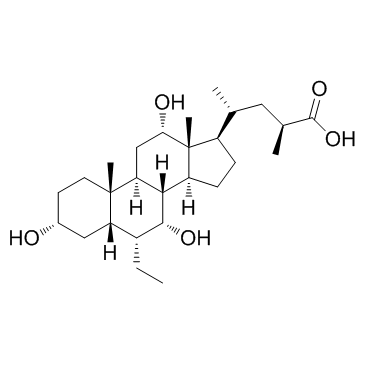1199796-29-6
| Name | (2S,4R)-4-[(3R,5S,6R,7R,8R,9S,10S,12S,13R,14S,17R)-6-ethyl-3,7,12-trihydroxy-10,13-dimethyl-2,3,4,5,6,7,8,9,11,12,14,15,16,17-tetradecahydro-1H-cyclopenta[a]phenanthren-17-yl]-2-methylpentanoic acid |
|---|---|
| Synonyms |
int 777
unii-utd8bcw6b8 INT-777 |
| Description | INT-777 is a potent TGR5 agonist with an EC50 of 0.82 μM. |
|---|---|
| Related Catalog | |
| Target |
EC50: 0.82 μM (TGR5)[1] |
| In Vitro | INT-777 is a novel potent and selective TGR5 agonist with remarkable in vivo activity[1]. INT-777 (3 μM) increases ATP production in the human enteroendocrine cell line NCI-H716 in a cAMP-dependent manner[2]. INT-777 (10 μM) lowers Isc and increases TEER when added on the serosal side of seromuscular stripped distal colon segments. INT-777 effect on basal secretion is reduced in neuron-free and TTX-treated mucosal-submucosal preparations[3]. |
| In Vivo | INT-777 (1 μM/min/kg, p.o.) has a potent choleretic effect, prevents carboxyl CoA activation and subsequent conjugation, thereby favoring its cholehepatic shunt pathway with a ductular absorption and a potent choleretic effect in HF-fed TGR5-Tg male mice[1]. INT-777 (30 mg/kg/day, p.o.) increases energy expenditure and reduces hepatic steatosis and obesity upon high fat feeding, and improves insulin sensitivity, in TGR5-Tg mice[2]. |
| Cell Assay | The experiments are carried out in STC-1 or NCI-H716 cells treated with vehicle (DMSO) or INT-777. INT-777 is assessed for its agonistic activity on TGR5. cAMP production is performed. Cytochrome C oxidase activity is evaluated by following the oxidation of fully reduced cytochrome C at 550 nm. ATP/ADP ratio and GLP-1 release is measured according to the manufacturer's instruction. Primary brown adipocytes are prepared and ileal explants are prepared. |
| Animal Admin | Age-matched male mice are used for all experiments. Genetically engineered mouse models (GEMMs), i.e. TGR5-Tg and TGR5-/- mice are generated. Diet-induced obesity (DIO) in the GEMMs or C57BL/6J mice is induced by feeding 8-week-old mice with a HF-diet (60%Cal/fat, D12492) for at least 8 weeks, as mentioned in the text and figure legends. In the dietary intervention experiments, INT-777 is mixed with diet at the dose sufficient to reach an in vivo dose of 30mg/kg/d. Mouse phenotyping experiments are performed according to EMPRESS protocols and aimed to assess food and water intake, body composition, energy expenditure, glucose and lipid homeostasis, and plasma biochemistry. |
| References |
| Molecular Formula | C27H46O5 |
|---|---|
| Molecular Weight | 450.65100 |
| Exact Mass | 450.33500 |
| PSA | 97.99000 |
| LogP | 4.33080 |
| Storage condition | 2-8℃ |
